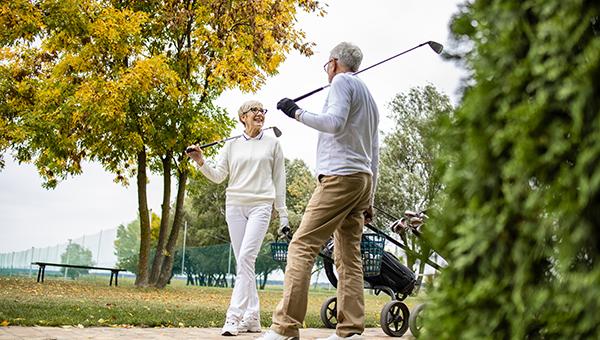Study Touts Benefits of Exercise as Primary CVD Prevention in Older Adults
Incident CV events were lower in men and women who were consistently active versus those with low levels of daily exercise.

A 20-year study of older people suggests that incorporating moderate-to-vigorous daily exercise and maintaining it as you age helps prevent CV events and early death.
Being physically active had the greatest influence on reductions in CV events at age 70, with no impact on older participants, suggesting “when it comes to being physically active, the sooner, the better,” lead study author Claudio Barbiellini Amidei, MD (University of Padua, Italy), said in an email. “The main message of the study is that physical activity seems to be more effective in preventing the onset of cardiovascular diseases early, rather than . . . in late life.”
Study participants age 65 years or older who reported at least 20 minutes per day of physical activity had lower risks of CVD, CAD, and heart failure than those who were inactive. That level of daily exercise also was associated with statistically significant mortality reductions in both men and women (HR 0.72; 95% CI 0.62 to 0.84, and HR 0.81; 95% CI 0.72 to 0.92, respectively) compared with not being active.
Amidei and colleagues say the findings “suggest that public health policies should be targeted at promoting or beginning physical activity in mid- and early late life, given a probable greater effectiveness in reducing cardiovascular risks.”
Commenting for TCTMD, James N. Kirkpatrick, MD (University of Washington Medical Center, Seattle), chair of the American College of Cardiology’s geriatric section, said while the World Health Organization (WHO) has previously set a goal of 20 minutes per day of moderate-to-vigorous exercise in older individuals, the evidence base for the recommendation has been lacking.
“In this study, they demonstrated that the 20-minute cutoff was associated with health benefits, particularly the avoidance of incident cardiovascular disease,” Kirkpatrick said. “Part of what’s interesting about this study is that primary prevention is often questioned in older individuals because we don't think they're going to live long enough to accrue the benefits. Studies like this are showing, or at least suggesting, that that may not be the case.”
Also commenting on the study for TCTMD, Paul Thompson, MD (Hartford Hospital, CT), said the findings also support the US Department of Health and Human Services’ 2018 Physical Activity Guidelines for Americans, which recommend 150 minutes per week of brisk walking.
While that may be ideal, realistically, Thompson said he tells patients to find something they enjoy and do it every day.
“If they enjoy bird-watching, and getting out and watching birds is their activity, then they ought to do that, but in general, my recommendation to patients is always to move more, sit less,” he said.
Fewer Events in Active Men and Women
For the Progetto Veneto Anziani-Pro.V.A. study, published online February 14, 2022, ahead of print in the BMJ, Amidei and colleagues enrolled 3,099 men and women ages 65 years or older (mean age 75 years; 60% female) between 1995 and 1997, with follow-up visits at 4 and 7 years. Questionnaires were used to collect physical activity data, including hours spent each week on specific activities. As defined by the WHO, moderate physical activity included walking and outdoor games or sports that require moderate physical exercise. Vigorous physical activity included gardening, working out at the gym, biking, dancing, and swimming. Participants were defined as active or inactive based on a cutoff of > 20 or ≤ 20 min/day for any of these activities.
The study also looked at physical activity trajectories to see how changing exercise habits with increasing age impacted the primary outcome of incident CVD. The trajectories classified activity as stable-low, high-decreasing, low-increasing, and stable-high. Compared with women, men reported more frequent smoking and alcohol use, while women had more comorbidities, including osteoarthrosis, osteoporosis, and chronic kidney disease.
In men, being active versus inactive was associated with less incident CVD (HR 0.74; 95% CI 0.58-0.94), CHD (HR 0.66; 95% CI 0.50-0.87), and heart failure (HR 0.72; 95% CI 0.53-0.98). Similar reductions were seen in women, but they did not reach statistical significance. The physical activity trajectory data suggested that virtually everyone, except those in the stable-low level of physical exercise category, reaped benefit in the form of reduction in CV events.
To TCTMD, Amidei noted that unlike what can be easily achieved nowadays with accelerometers on phones and smartwatches, the questionnaires used in the study were limited in their ability to objectively assess physical activity. As for the reductions not meeting statistical significance in women, he said the questionnaires may not have captured their activities accurately, making it harder to distinguish women that were actually physically inactive.
Exercise is still one of those things that we don't pay enough attention to, and we don't give exercise prescriptions out as much as we should. James Kirkpatrick
“That said, I would not focus too much on statistical significance, but rather observe how despite the above-mentioned limitations, incidence rates of cardiovascular diseases and overall mortality were nonetheless lower among women who were categorized as physically active and who certainly practiced some form of physical activity,” he said.
Kirkpatrick noted that women in the study had more osteoarthritis than men, which could have had an impact on activity as well. Overall, he said the trajectory data add new information about physical activity over time as we age and improves on more-simplistic point estimates.
“It's not surprising, of course, especially the findings that stable active people and those who were less active but increased their activity actually did better over time. I think it’s good to show that and it gives us some more confidence as we prescribe exercise in these early older age groups,” he said. “Exercise is still one of those things that we don't pay enough attention to, and we don't give exercise prescriptions out as much as we should.”
Amidei said future research looking at the role of age and light physical activity on CV risk reduction also might be of importance.
In an accompanying editorial, Enrico Fabris, MD, and Gianfranco Sinagra, MD (University of Trieste, Italy), note that there was no impact of exercise on stroke reduction despite the fact that stroke shares numerous common risk factors with ischemic heart disease. One reason for this, they say, could be the higher prevalence of atrial fibrillation in older people, with the possibility that cardioembolic stroke could dilute the effect of exercise on overall stroke occurrence in late life. They say further research is needed to “focus on the association between [physical activity] intensity and duration and stroke risk in older people.”
L.A. McKeown is a Senior Medical Journalist for TCTMD, the Section Editor of CV Team Forum, and Senior Medical…
Read Full BioSources
Amidei CB, Trevisan C, Dotto M, et al. Association of physical activity trajectories with major cardiovascular diseases in elderly people. Heart. 2022;Epub ahead of print.
Fabris E, Sinagra G. Physical activity in older people: better late than never, but better early than late. Heart. 2022;Epub ahead of print.
Disclosures
- Amidei, Fabris, Sinagra, Kirkpatrick, and Thompson report no relevant conflicts of interest.




Comments